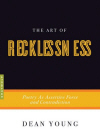The Art of Recklessness
“My argument is abandon and tells me to abandon every argument.”
“My argument is abandon and tells me to abandon every argument.”
This, Young’s first work of poetics or prose about poetry, is written in an offhand, talky manner: by turns like an e-mail or comment stream to the endless listserv and blog debates about the usefulness of MFAs, repurposed essays, advice gleaned from conversations with other poets, quotes from authors who have come before his poetry (all male but Stein), and metaphors – more or less useful, often flogged to death.
The first major point he makes is that poetry doesn’t hurt anyone and people attempting to write poetry can’t hurt Poetry. He makes his case intelligently, in sympathy with both unschooled would-be poets and beleaguered poetry students and/or workshop leaders, yet not in an unduly professorial way deriving its authority from his named chair or prestigious fellowships. Yet, while Young compares poetry to fire-as-a-classical-element, how can poetry of great power, emotional force, elemental strength, “assertive force,” be harmless? Is this a poetry which is not mightier than the sword, or which cannot forge swords into plowshares?
Young devotes much of his attention to the poetry with which he is somewhat idiosyncratically associated: Coleridge and Wordsworth of the Romantics, and the schools of twentieth century art and writing, Dada, Surrealism, OuLiPo, and the New York School. “Idiosyncratically,” since Young is associated in a different way with these lineages than the second and third generation New York School writers, many of whom studied or worked with the first group of New York School writers, the new conceptual poets’ NuLiPo’s association with current members of OuLiPo, the Beats and the surrealists, the ethnopoets and Dada through Jerome Rothenberg, or the langpos and their students with any of these lineages, including Romanticism.
This difference is important since, for example when considering the Dadaists, “All dada’s proponents shared a profound disgust with society, politics, and culture, and chose to make a celebration and debacle of this disgust.” Later on the same page, talking about some of their happenings/protests, he comments, “Sounds like the usual military operation to me.” Really? The first radically pacifist art movement in the 20th century used the military tactics of the time, which were based on stasis and antiquated, rigid strategy in the face of overwhelming technology? Or is this a hidden reference to the term avant garde?
Is Dada’s lesson idiocy, the violent opposite of its violent nihilism, and to be rejected in favor of Young’s union of irreverence and its opposite, the reverence, reference, “faith,” or “fidelity” of language (not the reverence or fidelity of craft)? Is the idea of “play” present in Stein, but not in OuLiPo, which “tells us nothing of life”? Yet idiocy is important to Young, as a tool to get to the truth, as a means to vision and revision “making strange” before the poet lends the coherence of art and language, not as an end. It is in this difference that the “contradiction” of the title occurs. The metaphors here are centripetal force vs. centrifugal meaning. The Art of Recklessness is a long plea for a dialectic poetry based on a series of dichotomies.
Young quotes William de Kooning to emphasize Young’s definition of recklessness, which is a conviction arising perhaps out of the surrealist idea of “first thought, best thought.” In discussing an asemic work of Man Ray’s, he considers it a way to articulate what can’t be articulated; poetry as code and reading as deciphering. Reader/Response theory becomes the rule of thumb, “Poetry endeavors to make the reader a poet.” Among the definitions and quotes are other thoughts about profligacy and proliferation, about imagination as a sort of trial and error, i.e., as an existential ideal. He prefers the fragmentary survival of a whole to a fragmentary presentation of a nexus.
How useful is Dean Young’s book? He’s introduced some opinions and materials that even still can be difficult for some students in rather dull writing programs to access. The chatty tone of the book does not easily display his meanings. Many of these meanings may have been more richly encapsulated in poems. But, neither is it like reading turgid literary theory. If encountered on a comment stream on fragments, one might think “don’t get him started on fragments!” or, equally likely, “Hmmm.” In a book, to serve as an introduction of the “out there” for the isolated, a table of contents with a list of the section breaks (there are no chapters), a bibliography with a list of people and texts quoted (many in their entirety, many with equally important translators as authors) is necessary.





